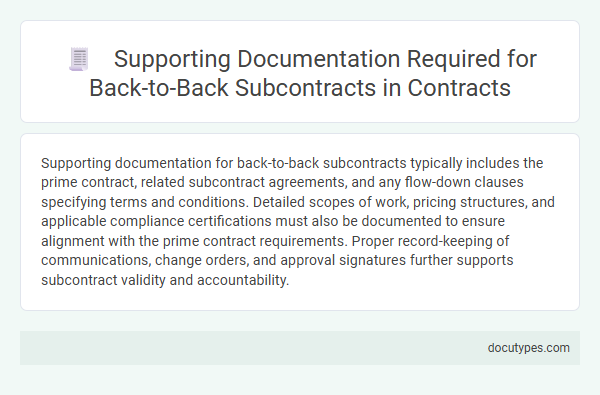Supporting documentation for back-to-back subcontracts typically includes the prime contract, related subcontract agreements, and any flow-down clauses specifying terms and conditions. Detailed scopes of work, pricing structures, and applicable compliance certifications must also be documented to ensure alignment with the prime contract requirements. Proper record-keeping of communications, change orders, and approval signatures further supports subcontract validity and accountability.
Introduction to Back-to-Back Subcontracts
Back-to-back subcontracts align subcontract terms directly with the prime contract to ensure consistent obligations and protections. Understanding the necessary supporting documentation helps you maintain compliance and manage risk effectively.
- Prime Contract Copy - Provides the foundational terms and conditions that apply to the subcontract.
- Subcontract Agreement - Details the specific obligations and expectations between the contractor and subcontractor.
- Flow-down Clauses - Identifies mandatory clauses from the prime contract that must be included in the subcontract.
Proper documentation streamlines communication and enforces accountability within back-to-back subcontract arrangements.
Importance of Supporting Documentation
| Topic | Details |
|---|---|
| Supporting Documentation | Copies of prime contract clauses, flow-down requirements, and subcontractor proposals are essential. |
| Invoices and Payment Records | Accurate invoices, payment schedules, and receipts validate financial transactions. |
| Technical Specifications | Engineering drawings, product specifications, and quality assurance records ensure compliance. |
| Compliance Certificates | Certifications for regulatory adherence, safety standards, and material quality must be documented. |
| Change Orders | Documentation of contract modifications, approvals, and impact assessments is required. |
| Importance | Supporting documentation provides transparency, reduces risk, and supports dispute resolution. Maintaining thorough records establishes accountability, ensuring Your subcontract aligns with prime contract terms. |
Common Types of Supporting Documentation
Back-to-back subcontracts require specific supporting documentation to ensure compliance and proper contract execution. Accurate and thorough documentation facilitates smooth verification and approval processes.
- Subcontract Agreement - A signed copy of the subcontract outlining terms, deliverables, and responsibilities.
- Purchase Orders - Official purchase orders specifying quantities, prices, and delivery schedules related to the subcontracted work.
- Invoices and Payment Records - Detailed invoices paired with payment confirmations to validate financial transactions under the subcontract.
Prequalification and Due Diligence Documents
Supporting documentation for back-to-back subcontracts primarily includes prequalification and due diligence documents to ensure compliance and performance standards. These documents verify the subcontractor's financial stability, legal standing, and technical capabilities.
Prequalification materials often consist of completed questionnaires, financial statements, and certifications relevant to the contract scope. Due diligence requires reviewing licenses, insurance certificates, past project references, and compliance records to mitigate risks effectively.
Scope of Work and Technical Specifications
Supporting documentation for back-to-back subcontracts must clearly define the Scope of Work to ensure alignment between the prime contract and the subcontract. Detailed Technical Specifications are essential to provide precise requirements and performance standards for the subcontractor. You should include these documents to facilitate clarity, compliance, and successful project execution.
Compliance Certificates and Licenses
What supporting documentation is required for back-to-back subcontracts, specifically regarding compliance certificates and licenses? Compliance certificates must validate that all subcontracted work meets regulatory and contractual standards. Your subcontractors are required to provide valid licenses ensuring legal authorization to perform the contracted tasks.
Insurance and Bonding Requirements
Supporting documentation for back-to-back subcontracts must include detailed proof of insurance and bonding compliance to protect all parties involved. Your subcontractors are required to provide evidence that meets the primary contract's insurance and bonding obligations.
- Insurance Certificates - Subcontractors must submit valid certificates of insurance covering liability, workers' compensation, and any project-specific requirements.
- Surety Bonds - Performance and payment bonds must be provided to guarantee subcontractor commitments and financial responsibility.
- Compliance Verification - Documentation must demonstrate adherence to the insurance limits and bond amounts stipulated in the prime contract.
Subcontractor Performance Records
Subcontractor performance records are crucial supporting documentation in back-to-back subcontracts. These records provide detailed insights into the subcontractor's past work quality, adherence to deadlines, and compliance with contract specifications.
Including performance records helps ensure accountability and facilitates risk management in contract execution. Contracting parties rely on these documents to evaluate subcontractor reliability and to support decision-making processes.
Payment and Financial Documentation
Supporting documentation for back-to-back subcontracts must include detailed payment and financial records to ensure proper fund allocation and compliance. Accurate invoices, payment schedules, and proof of transactions are essential for verifying financial commitments between parties.
Payment documentation should encompass original invoices, receipts, and payment authorization forms that align with the prime contract terms. Financial reports such as cost breakdowns and budget reconciliations help track expenditures and prevent discrepancies. These documents collectively facilitate audit readiness and maintain transparency throughout the subcontract process.
What Supporting Documentation Is Required for Back-to-Back Subcontracts? Infographic

